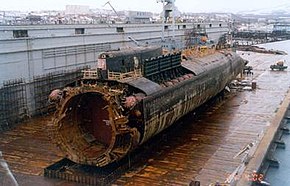Kursk submarine disaster

Wreck of K-141 Kursk in a
floating dock at Roslyakovo |
|
| Time | 11:29:34 a.m. – 11:31:48 a.m. |
|---|---|
| Date | August 12, 2000 |
| Location | Barents Sea |
| Coordinates | 69° 36′ 0″ N, 37° 34′ 0″ E |
| Cause | Faulty weld on a 65–76 "Kit" practice torpedo, leading to an explosion of high-test peroxide and detonation of 5 to 7 torpedo warheads |
| Outcome | Loss of the ship and crew |
| Deaths | 118 (all) |
| Convictions | None |
The Kursk submarine disaster, the sinking of the Oscar-class submarine (Russian: Project 949A Антей) Kursk, took place during the first major Russian naval exercise in more than ten years, in the Barents Sea on 12 August 2000, killing all 118 personnel on board. Nearby ships registered the initial explosion and a second, much larger, explosion two minutes and fifteen seconds later, which was powerful enough to register on seismographs as far away as Alaska. The Russian Navy did not realise that the sub had sunk and did not halt the exercise or initiate a search for it for more than six hours. Because the emergency rescue buoy had been intentionally disabled, it took more than 16 hours for them to locate the sunken ship.
Over four days the Russian Navy used four different diving bells and submersibles to try to attach to the escape hatch without success. The navy's response was criticised as slow and inept. The government initially misled and manipulated the public and media about the timing of the accident, stating that communication had been established and that a rescue effort was under way, and refused help from other governments. The Russian Navy offered a variety of reasons for the sub's sinking, including publicly blaming the accident on a collision with a NATO submarine. On the fifth day, President Vladimir Putin authorised the navy to accept British and Norwegian offers of assistance. Seven days after the submarine went down, Norwegian divers finally opened a hatch to the escape trunk in the ship's ninth compartment, hoping to locate survivors, but found it flooded.
An official investigation after most of the wreck was raised along with analysis of pieces of debris concluded that the crew of Kursk was preparing to load a dummy 65–76 "Kit" torpedo when a faulty weld in the casing of the practice torpedo caused high-test peroxide (HTP) to leak, which caused the highly volatile kerosene fuel to explode. The initial explosion destroyed the torpedo room, ignited a fire, severely damaged the control room, incapacitated or killed the control room crew, and caused the submarine to sink. The intense fire resulting from this explosion in turn triggered the detonation of between five and seven torpedo warheads after the submarine struck bottom. This second explosion was equivalent to between 2 and 3 tonnes (2.0 and 3.0 long tons; 2.2 and 3.3 short tons) of TNT. It collapsed the first three compartments and all the decks, tore a large hole in the hull, destroyed compartments four and five, and killed everyone still alive who was forward of the nuclear reactor in the fifth compartment. An alternative explanation to the faulty weld offered by critics suggested that the crew was not familiar with nor trained on firing HTP torpedoes and had unknowingly followed preparation and firing instructions intended for a very different type of torpedo. Combined with poor oversight and incomplete inspections, the sailors initiated a set of events that led to the explosion.
...
Wikipedia
